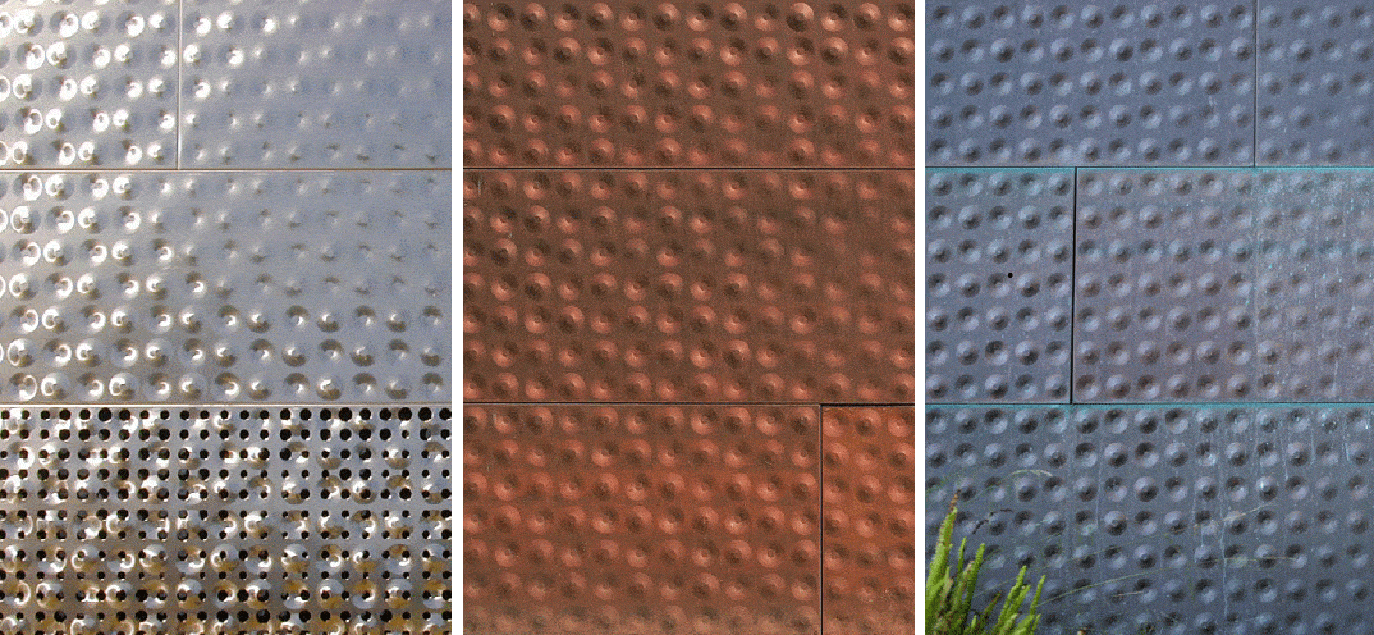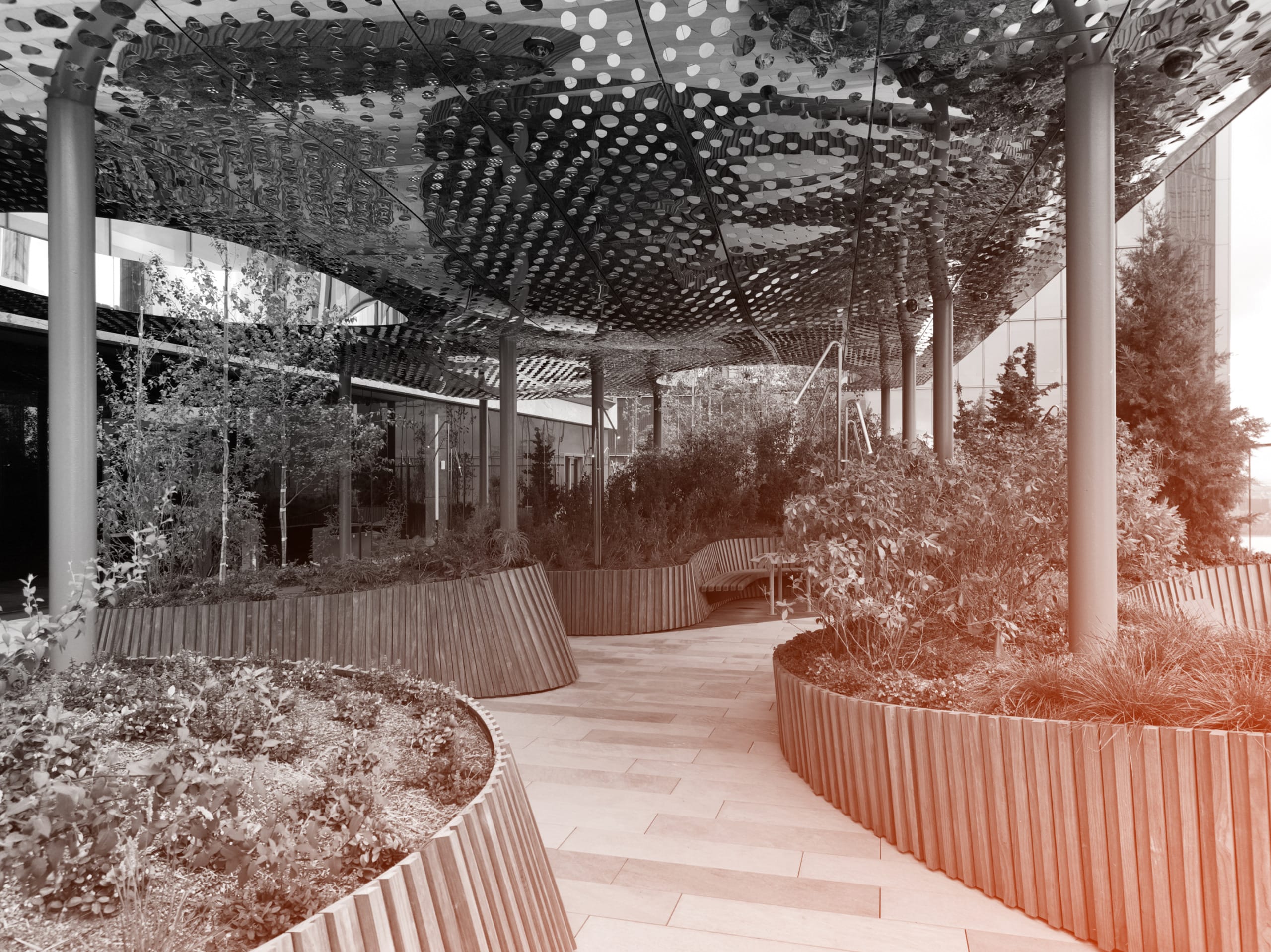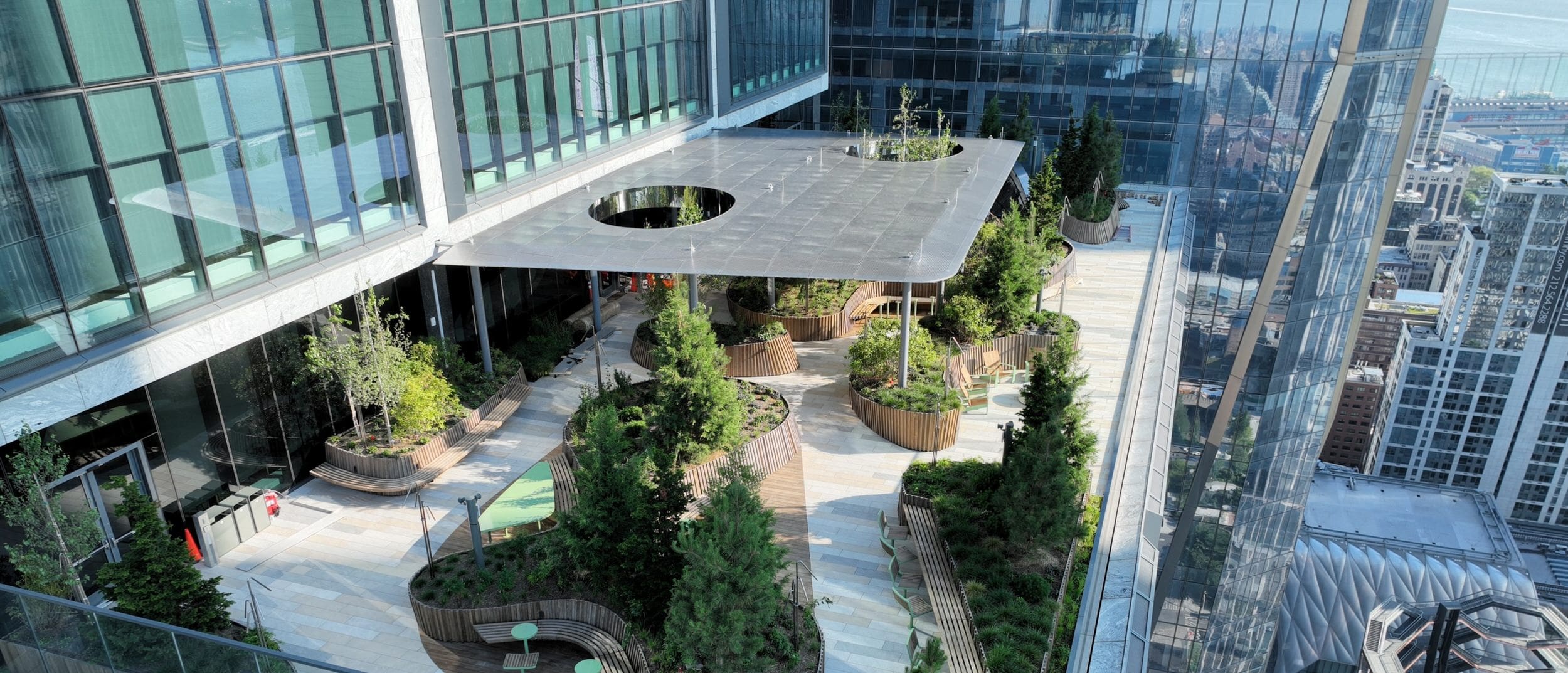Copper Guide Part 4: Star Blue™ — Zahner’s Blue-Green Copper Patina
While competitors often make their copper patinas look uniform, like paint, Zahner strives to do the opposite with a layering technique that creates beautiful toning effects.
Star Blue™ copper is a preweathered surface developed and offered by A. Zahner Company. This blue-green patina allows artists and architects to accomplish an aged copper look without the wait.
Deep green natural patinas, which used to take a decade or so to develop in more polluted conditions, will take a century or more in our modern world. Star Blue provides an answer.
Using a technique that speeds up the weathering process in a tightly controlled environment, the blue-green antiqued appearance is ready in a matter of weeks.
After a carefully rolled application of Star Blue, the patinated copper may be installed on wall paneling systems, roofing systems, and architectural accents, in addition to art and sculpture projects of any scale.
The Kansas City Star Production Facility.
PHOTO © A. ZAHNER COMPANY.CLOSE-UP OF STAR BLUE COPPER CLADDING ON THE KANSAS CITY STAR PRODUCTION FACILITY.
PHOTO © A. ZAHNER COMPANY.DETAIL OF THE KANSAS CITY STAR PRODUCTION FACILITY.
PHOTO © A. ZAHNER COMPANY.Star Blue™ For The Kansas City Star
Star Blue was first installed as an exterior surface for the Kansas City Star Production Facility, designed and developed by The Austin Company. Collaborating with this engineering design firm, Zahner developed the preweathered copper patination system.
This significant project marked the first large-scale application of Zahner’s proprietary rapid-patination process, and an estimated 4,155 Star Blue copper panels were installed on the facility’s surface in a combined 80,000 SF of surface area.
Such a large installation highlights the mottled and variegated green surface of Star Blue. Along with a memorable appearance, the patina offers a layer of natural protection for the copper alloy.
Following installation, nature steps in to deepen the layered tones with time. This uncommon variation in color and texture is unique in the architectural metals community. It breaks from the uniform monotony often experienced on large building surfaces and is what sets Star Blue apart.
DETAIL OF THE COPPER AND GLASS FACADE OF SUNY NEW PALTZ.
PHOTO © A. ZAHNER COMPANY.Creating Artificial Green Patinas
Star Blue and other artificial green patinas are decorative treatments to copper alloy surfaces, with their planned chemical reactions on the surface between the copper and chemical compound.
They mimic what occurs naturally when copper is exposed to the atmosphere but are produced in a concentrated and controlled environment.
Artists and architects working with green patinas can arrive at a desired color tone while dramatically accelerating the time of development.
When first installed, the patina will exhibit the color tone produced in the factory. But after a few months of exposure, the patina will develop a richer hue as it absorbs moisture from the air (as well as from carbon dioxide and other pollutants).
Custom copper patina on interior metal panels at the SMU Collins study room.
Photo © A. Zahner Company.SMU Collins Center balconies in the main atrium.
Photo © A. Zahner Company.Detail of the artistic pre-patinated copper at SMU Collins.
Photo © A. Zahner Company.There are no dyes or pigments in the patination process. Instead, a chemical reaction with the copper is required. This chemical reaction takes time. Only time will allow the copper ions to diffuse out and combine with the oxygen to form an initial layer of cuprous oxide.
As the reaction continues, the copper ions join with sulfides, chlorides, and other substances entering the moist layer and becoming ions in the solution.
One should be aware that when the green patination solution is first applied, the surface changes and the green tones begin to develop. As with paint, the impulse may be to add more solution to thicken the coating.
However, adding additional layers will prevent the first reaction from taking hold. It is important to lead with a lighter hand and to allow the necessary time for this reaction to complete.
PATINA TRANSITION OVER TIME ON THE DE YOUNG MUSEUM.
PHOTO © A. ZAHNER COMPANY.Signs of green patina along the panel seams of THE DE YOUNG MUSEUM.
PHOTO © A. ZAHNER COMPANY.Skillful Verdigris, Colorful Benefits of Star Blue
Architectural copper panels are typically installed as raw or ‘red’ copper sheets. The color progresses from reflective pinks and reds to a matte brown. However, it will take decades before the metal patinates into the blues and greens so desired for architectural projects.
This installation of unpatinated copper can be seen at the de Young Museum in California, where Zahner manufactured and installed a panel system in 2003-2005.
Fast forward a decade, one can identify subtle signs of green along the panel seams, but the overall tone reflects a deep brown color reminiscent of burnt umber. It’s projected to be another few decades before the surface takes on a green hue.
Detail of the Star Blue™ copper panels at SUNY New Paltz Student Union Building.
PHOTO © A. ZAHNER COMPANY.Artificial green patinas are a popular choice for immediate blue-green color effect. Such patinas are achieved through a chemical process involving copper acetate called verdigris.
The issue with this verdigris is that it can leave the material in a soluble state if attempted without expert precision.
The Zahner standard offers a level of mastery when taking verdigris to an insoluble state. The technicians initiating this process ensure that the patina properly fuses to the surface. This is Star Blue: a chemically stable patina surface produced safely using rapid-patination.
Enjoying this article? Take a deeper dive with:
Copper, Brass, and Bronze Surfaces: A Guide to Alloys, Finishes, Fabrication, and Maintenance in Architecture and Art (Architectural Metals Series)
By L. William Zahner
Copper, Brass, and Bronze Surfaces, third in Zahner’s Architectural Metals Series, provides a comprehensive and authoritative treatment of copper, brass, and bronze applications in architecture and art. It offers architecture and design professionals the information they need to ensure proper maintenance and fabrication techniques through detailed information and full-color images. It covers everything from the history of the metals and choosing the right alloy, to detailed information on a variety of surface and chemical finishes and corrosion resistance.
Star Blue In Application
Both artistic vision and scientific understanding are required in the Star Blue patination process. Zahner trains experts in both areas.
This dual approach creates a high-performance, artful patinated panel that stands apart from the uniform, less inspired machine-produced patinas.
This contemporary and unconventional appeal makes Star Blue popular among forward-looking designers and architects, as well as their institutional clients. It is no surprise that the following examples include a university, a library, an art museum, and an embassy.
STUDENTS WALKING AMIDST THE BLUE COPPER FACADE of the Instructional Centre.
PHOTO © LISA LOGAN, COURTESY OF PERKINS + WILL ARCHITECTS.Students walk up and down the main staircase.
Photo © Lisa LoganTHE MOOD OF THE PATINATED COPPER INTERIOR WALLS CHANGES DURING THE EVENING.
PHOTO COURTESY OF PERKINS + WILL ARCHITECTS.In designing The Instructional Centre at The University of Toronto, the architects at Perkins+Will wanted an artistic patina that would reveal bare copper in some areas while reflecting dark tones in others.
The mottled appearance of Star Blue fit the description and was further customized for artistic effect before application to the center’s exterior and interior surfaces.
Manufactured in a controlled environment by Zahner while modifying its application technique, this patina was developed in a matter of weeks by chemically oxidizing the copper.
THE BRANDYWINE HUNDRED LIBRARY IN NEW CASTLE COUNTY.
PHOTO COURTESY OF THE FRIENDS OF BRANDYWINE HUNDRED LIBRARY.Two hundred and ninety sheets of Star Blue patinated copper were fabricated by Zahner for The Brandywine Hundred Library in New Castle.
Designed to enhance modern interconnectivity, a unique and rustic copper patina canopy greets guests at this 40,000-gross-square-foot library.
COLUMBUS MUSEUM OF ART, EAST FACADE, GLASS, AND PATINATED COPPER.
PHOTO BY JEREMY PURSER, © A. ZAHNER CO.The new Margaret M. Walter Wing of the Columbus Museum of Art welcomes the visitors and residents of Columbus, Ohio, to global exhibitions hosted there annually.
The structure is a contemporary work of architecture that links the museum’s rich history with visions of an expansive future.
This sentiment is mirrored as modern architectural touches interplay with a cohesive surface of antiqued copper: A custom variation of Star Blue.
The Jakarta Australian Embassy.
Photo COURTESY OF THE AUSTRALIAN EMBASSY JAKARTA.THE AUSTRALIAN EMBASSY COMPLEX IN JAKARTA.
Photo COURTESY OF THE AUSTRALIAN EMBASSY JAKARTA.THE AUSTRALIAN EMBASSY COMPLEX IN JAKARTA.
Photo COURTESY OF THE AUSTRALIAN EMBASSY JAKARTA.Star Blue was chosen as an exterior surface material for the Jakarta Australian Embassy alongside Solanum Steel, Hunter Zinc, and anodized aluminum. Framed between these contrasting metals, Star Blue’s unique green color shines forth.
More Examples of Star Blue in Application:
OCULUS SCULPTURE by Reilly Hoffman.
PHOTO © A. ZAHNER COMPANY.Star Blue for the Arts
Artistic expression can be enhanced by the colorful tones of Star Blue on smaller surfaces. Zahner has spearheaded several sculptural projects that utilize this patina.
The Oculus Sculpture, by artist Reilly Hoffman, was produced in conjunction with the Kansas City Art Institute’s Biennial Auction for Student Scholarships.
Zahner manufactured the base form in aluminum, while Hoffman crafted the copper and steel with his signature torch-carving techniques.
The large, curved sculpture is finished with Star Blue patina on hammered copper to create an iridescent blue-green color across the back and inner sections.
While an impressive object without this added pop, the Star Blue application adds eye-catching detail and brightening contrast against the sealed red copper and steel.
HEARTLAND HARVEST AT THE KANSAS CITY BOARD OF TRADE.
PHOTO © A. ZAHNER COMPANY.Heartland Harvest, a 60-foot tall sculpture finished with Star Blue, was installed on the Kansas City Board of Trade building in 1999.
Designed by Joel Marquardt of Gastinger Walker Harden Architects, a miniature maquette was created and shared with Zahner engineers.
The team designed a custom “on-off” press to replicate the models exact indentations in Star Blue patinated copper.
Resilience To Atmospheric Elements
Star Blue patinas on rooftops and facades worldwide can perform well in all environments. Exposure to moisture, oxygen, and carbon dioxide enrich these surfaces very slowly over time, similar to naturally forming patinas.
Roof surfaces are especially subject to rain, hailstorms, ultraviolet radiation, and particles of pollutants coming out of the atmosphere. These tend to remain on the surface for a prolonged period.
As moisture from condensation forms, these pollutants can combine with the copper patina with some darkening effects.
THE TSING YI TERMINAL ROOF IN HONG KONG.
PHOTO © A. ZAHNER COMPANY.Tsing Yi Station Terminal Roof includes custom fascia and flashing.
Photo © A. Zahner Company.CURVATURES ALONG THE PROFILE OF THE TSING YI STATION TERMINAL ROOF.
PHOTO © A. ZAHNER COMPANY.The Tsing Yi Terminal, designed by Wong Tung, features the largest copper roof in Hong Kong. Constructed from copper prepatinated with Star Blue, the roof and accompanying soffit overhang have held up well in a humid urban environment for over 20 years.
Zahner provided metalwork for the project and developed an advanced patina on the copper in the United States before it arrived in Hong Kong.
This built-up oxide offered the immediate protective layer required for a durable roof surface.
Environmental Control and Sustainability
Successful patination of copper surfaces can be particularly capricious due to slight variations in the metal surface, the temperature during and after patination, humidity, the strength of the chemistry, and an extensive number of other conditions that must be planned and adjusted for.
Prepatinated copper skins for Brandywine Hundred Library in the Zahner shop.
PHOTO © A. ZAHNER COMPANY.Soffit copper panels for the canopy.
PHOTO © A. ZAHNER COMPANY.The environment needs to be one of tight humidity and temperature control, which is one reason why patination of large architectural surfaces is extremely difficult and prone to failure.
Additionally, the chemicals used are not ones that you simply rinse down the drain; they must be contained and dealt with properly. Factory patination should be performed only by those that have proper collection, treatment, handling and re-use systems in place.
Keeping in step with Zahner’s sustainability mission, all our metal patinas are developed in the company’s EPA-certified facility. Practicing clean operations at this award-winning facility ensures that the patination process water is collected, treated and re-used, preserving the integrity of the community water supply.
FACADE FOR 178 NORTH ELEVENTH WITH ANTIQUE COPPER PATINA IN BROOKLYN, NEW YORK.
PHOTO @ A. ZAHNER COMPANY.Take Advantage of Zahner’s Star Blue
Star Blue is offered as a copper sheet product in a variety of standard thicknesses, ranging from 16 oz to 48 oz. It is also offered in additional thicknesses, or with custom fabrication based on your unique project’s needs. Reach out to Zahner sales associates for product samples or additional information.
- Request Samples
- Learn more about Star Blue
- Read Bill Zahner’s Copper, Brass, and Bronze Surfaces: A Guide to Alloys, Finishes, Fabrication, and Maintenance in Architecture and Art
- Call us at +1 (816) 474-8882
- Contact a Project Specialist


































 PHOTO © Tim Hursley
PHOTO © Tim Hursley









 PHOTO ©️ Parrish Ruiz de Velasco (parrch.com)
PHOTO ©️ Parrish Ruiz de Velasco (parrch.com)



 © Fedora Hat Photography
© Fedora Hat Photography Photo by Andre Sigur | ARKO
Photo by Andre Sigur | ARKO





 Ɱ, Creative Commons Attribution-Share Alike 4.0 International license, edited.
Ɱ, Creative Commons Attribution-Share Alike 4.0 International license, edited.


